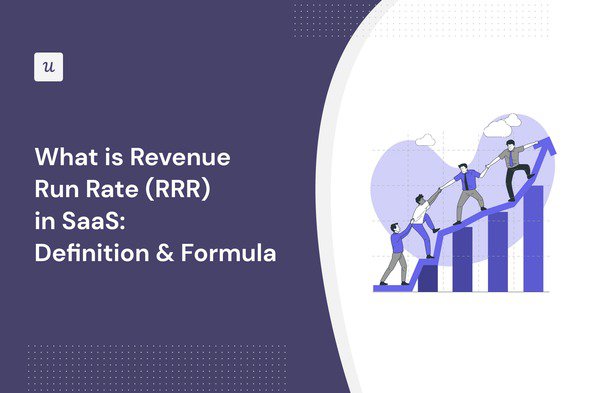
Revenue run rate (RRR) is one of the simplest metrics for developing a sound business strategy. When used right, it helps SaaS companies analyze and understand their current performance and forecast annualized revenue.
If you are a startup founder, understanding revenue run rate can help you predict growth rate even with limited data. It can also reveal your company’s performance to current and potential investors and provide clarity about whether you are achieving your key objectives through your products and services.
This article will discuss what revenue run rate is, how you can calculate it, its limitations, and practical applications of this valuable metric.
Try Userpilot Now
See Why 1,000+ Teams Choose Userpilot

What is the revenue run rate (RRR)?
Revenue run rate is a financial metric used to project a company’s revenue over a period (usually a year) based on past revenue data. In other words, it is the estimated future performance of a company.
It allows investors to use the company’s current performance to gain insight into the potential future revenue and trajectory of the business.
How to calculate revenue run rate
Calculating the revenue run rate is pretty straightforward. Take your current revenue data over a period of time, let’s say one month. Multiply the value by 12 to get the estimated revenue run rate calculation for an entire year.
You can calculate revenue run rate weekly, fortnightly, monthly, quarterly, and annually.
Here’s the revenue run rate formula:

If you have only one month’s data, this formula calculates the estimated run rate for the year since there are 12 months in one year:
- One month’s revenue x 12
Your estimated run rate will be even more accurate if you have the company’s quarterly data:
- One quarter’s revenue (3 months) x 4
The following formula helps you calculate the run rate no matter what period of data you have:
- (Total Revenue / # of Days in Period) x 365
Examples of revenue run rate calculations
To make sense of your company’s run rate, here are some examples:
Annual revenue run rate calculation example
Let’s consider company A, a fast-growing SaaS business, for this example. They want to calculate the company’s revenue run rate based on April, in which they posted $30,000 in revenue.
To calculate the annual run rate, Company A multiplies $30,000 by 12, arriving at $360,000.
$30,000 x 12 months = $360,000 revenue run rate
This is the simplest way to calculate the revenue run rate. To get a more accurate sum, divide the total revenue by the number of days in the period. Then, multiply the daily revenue by 365 (the number of days in a year).
$30,000/30 days in April = $1,000 daily revenue
$1,000 daily revenue x 365 = $365,000 annual run rate
You can also calculate the annual run rate using the quarterly data. If company A posted revenues of $85,000 in the first quarter (January to March), multiply $85,000 by 4 (the number of quarters in a year).
$85,000 revenue in Q1 x 4 quarters in a year = $340,000 annual revenue run rate.
Quarterly revenue run rate calculation example
To calculate the quarterly revenue run rate, divide the annual revenue run rate by 4.
Let’s say company A posted an annual revenue run rate of $300,000. The quarterly revenue run rate will be:
$300,000/4 = $75,000
Revenue run rate (RRR) vs Annual recurring revenue (ARR)
The terms revenue run rate and annual recurring revenue are often used interchangeably. However, there are simple differences. Revenue run rate is used to calculate any revenue, while actual recurring revenue is used for only recurring revenue.
The annual recurring revenue (ARR) is the sum of all revenue generated from customer contracts over one year. In other words, it is the sum of subscription revenue for 12 months + recurring revenue.
- The revenue run rate is used to predict annual revenue based on your company’s current pace of revenue.
- RRR operates on the assumption that recurring revenue will continue to be generated at the same rate.
- ARR is used by SaaS businesses to calculate the revenue from recurring subscription income. ARR only takes into account the recurring revenue generated by the business – it excludes one-time revenue.
Revenue run rate (RRR) vs Monthly recurring revenue (MRR)
Like annual recurring revenue, monthly recurring revenue is a measure based on subscriptions or membership fees.
- MRR assesses the short-term operational efficiency of your SaaS business while RRR provides long-term insight.
- MRR is ideal for new startups or companies that register monthly subscribers.
The disadvantages of using revenue run rate
Revenue run rate is a valuable tool for SaaS companies because it is simple to use.
However, it isn’t always the most accurate metric, as it relies on historical data, assuming that revenue will stay the same through a given period.
Here are some of the disadvantages of using revenue run rate:
Seasonal fluctuations
Many businesses experience seasonal fluctuations based on the time of the year. As a result, a single month’s earnings will not always accurately reflect profitability and yearly revenue.
For instance, if the company’s financial projections are based on off-season data, the revenue run rate will be lower than the actual annual revenue. On the other hand, if the revenue projections were based on data from their busiest months, the run rate would be inflated.
Remember Company A? If, for instance, they posted revenues of $20,000 in January, their run rate will be $240,000 – about $100,000 less than the run rate calculated using the April monthly data. While this does not invalidate either calculation, only one likely depicts a true reflection of the actual run rate.
Churn rates
SaaS businesses, like other subscription-based businesses, rely on subscriptions and memberships from customers. When customers do not renew subscriptions, this can affect the expected future revenue.
The revenue run rate assumes a constant return rate, which could lead to discrepancies between the run rate and the true company’s earnings.
New product release
The release of a new feature or product is typically greeted by increased interest from customers. Your revenue run rate may be inaccurate if you use data immediately after a product release.
One-time sales revenue
A large one-time purchase may not be a true reflection of a company’s ongoing operations and can throw off your SaaS revenue forecasting.
If you make the company’s annual revenue based on large one-time sales data, it can significantly inflate your run rate revenue.
When you should use the revenue run rate
Despite its limitations, revenue run rate helps in the following circumstances:
- New businesses: Revenue run rate can help young companies keep track of their financial performance. Since run rate can be calculated based on data over a short period, it can provide a near-perfect measurement of your company’s performance.
- Evaluating changes: The impact of changes in the pricing structure, leadership, and even the launch of new products and services can be evaluated using run rate. You can use run rates to track how changes have affected the financial performance of a company.
- Rapid growth and scaling: If your company experiences rapid revenue growth within a short period, you can use the financial data to calculate a run rate that may better forecast revenue for the future. However, keep in mind that growth rates can be inconsistent, and your assumption may not be the norm.
Conclusion
Revenue forecasts are an important part of company management, budgeting, and decision-making. The simplicity of the revenue run rate makes it attractive, but can also make it unreliable. However, if you keep its limitations in mind, it can be a valuable tool to help you keep track of your company’s financial health.
Are you looking to get started with using revenue run rate (RRR) for your business? Get a Userpilot demo and see how you can track growth and stay in charge of your company’s annual income.







